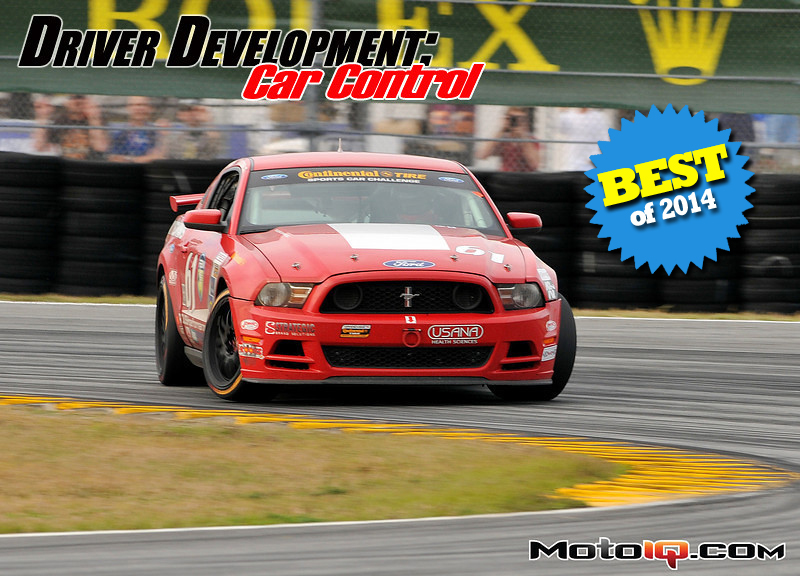 In this 2D tire model, we can see the relationship between the tire’s Coefficient of Friction (Grip) and the tire’s slip angle. This is a generalized graph of a street tire. The slip angle of a real tire’s peak level of grip will vary depending on the tire, load, and conditions.
In this 2D tire model, we can see the relationship between the tire’s Coefficient of Friction (Grip) and the tire’s slip angle. This is a generalized graph of a street tire. The slip angle of a real tire’s peak level of grip will vary depending on the tire, load, and conditions.
If we look at a friction (or lateral load) vs. slip angle graph for a tire, you will see that as slip angle is introduced into a tire, it develops lateral load, to a point. The peak of the graph is the maximum grip and peak friction that a tire will generate. The “Limit” of the tire, if you will. Once the slip angle has increased past this ‘limit’, the tire will start to lose grip. There are many different factors that affect the shape of this graph and how quickly a tire’s grip falls off once the limit is surpassed, from the tire compound, tread design, carcass design and internal ply placement, vertical loading, tire age, tire temperature, track temperature, etc…

Street tires tend to have soft sidewalls and small tread blocks which results in a broad curve around the friction peak. This makes driving at the limit easier since there is a gradual increase in grip to the limit and a gradual reduction in grip once the limit is surpassed; as opposed to the immediate drop in grip found in racing tires.
R-compound tires tend to have similar characteristics to street tires but with more grip, and a slightly more aggressive drop in friction past the limit. Full blown racing slicks have a tremendous amount of grip but usually have a much smaller window of useable operation. Once the limit is passed in some racing tires (like those found in NASCAR), they can have such a significant drop in lateral grip that it can feel as if the car has hit a patch of water. This makes racing slicks difficult to control past the limit and far from ideal for drifting.

I would define CAR CONTROL as the sensitive ability of a driver to induce intended actions of a car at and beyond the peak limit of grip of the tire, through his or her inputs. This covers everything from creating an intended slide to adjust the yaw angle and trajectory of the car, to catching an unintended slide, to making the car behave in a certain manner that best keeps all four tires at their limits at all times to yield the fastest lap possible.
It is often said that really good drivers don’t inherently have great reflexes, but rather can anticipate what the car is going to do and adjust their inputs as an unwanted event is occurring, not in reaction to it. Just like any trade, it takes practice and seat time to build the comfort and muscle memory to be proficient at good car control. While some drivers may be comfortable in and have good car control in a certain car, it might not always transfer over to a different car for them. Although physics is physics and car control is essentially the same for every car, the application and magnitude of inputs will change with the intricacies of a different platform. The goal here is to better understand car control so it transcends beyond a specific car for the reader and can be applied to anything they drive. Now let’s get back to the three car control categories.





9 comments
Great article! Had to follow up here after the Speed Secrets weekly left me hanging on the definition of the refined driver!
Thanks for listening in and reading this here!
I have been using a simulator to get more comfortable with driving beyond the limit. On track, as soon as the problem occurs, I generally have the developed muscle memory necessary to get out of the trouble I created. It replaced some of the other questionable methods I used to cut my teeth as a younger adult.
Like Ernie (above), I found this article after reading Ross’s latest Speed Secrets Weekly. I am a club racer, and tend to be very timid about losing control of the car by going past the limit. I took a one day Car Control Clinic at Lime Rock earlier this year, and developed some confidence in going over the limit at low speeds. But at higher speeds, on a dry, fast track, it is still a struggle. I will be driving at Thompson in CT next month, that has some slow corners with wide runoff. I’ll drive on worn out tires, and force myself to do some sliding!
Great article Billy. I have been driving at HPDE’s for 3 years now and agree with what you say. I’ve had some instuctors push me past my current limits and helped me get faster only to come back to the same track and have an instructor slow me down and not let me drive to my current abilities.
Thank you for such detail in the article. I have found my place as a driver just by reading this. Now I can focus on the next area of improvement for myself.
I absolutely enjoyed reading this. This is exactly the Aviation-level, in depth ground school that teaches you how to think about what you’re doing. -And how to understand reality for what it is. I know this will provide a solid foundation for my first HPDE event later this year. Thank you.
Thank you for the feedback, I am glad to hear it!
Wow! What a great read. Thank you for taking the time to explain this in all the detail that you did! I know where I am behind the wheel and where I wish to go. This article was exceptional. I can’t wait to gain more seat time and practice car control more and more!